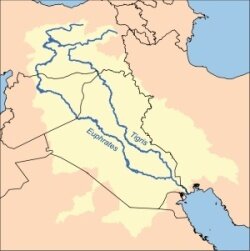
The Tigris is the eastern member of the pair of great rivers that define Mesopotamia (the name "Mesopotamia" is a Greek word meaning "the land between the rivers"), along with the Euphrates, which flows from the mountains of Anatolia through Iraq.
The original Sumerian name was Idigna or Idigina, which can be interpreted as "the swift river"[4] or "the river that goes", contrasted to its neighbor, the Euphrates, whose leisurely pace caused it to deposit more silt and build up a higher bed than the Tigris. This form was borrowed and gave rise to Akkadian Idiqlat. Either through a Persian intermediary or borrowed directly from Akkadian, the word was adopted into Greek as Tigris.
In Pahlavi, tigr means "arrow" (in the same family as Old Persian tigra-, Modern Persian têz "sharp"). However, it does not appear that this was the original name of the river, but that it (like the Semitic forms of the name) was coined as an imitation of the indigenous Sumerian name. The name of the river in English and many other languages — Tigris — is from Ancient Greek, which was in turn derived from the Persian.
It is also possible that the name Tigris, and the variants in Dicle, derives from Kurdish. In Kurdish, tij means "sharp", referring to the Tigris as a sharp and fast river.
Another name for this watercourse, used from the time of the Persian Empire, is Arvand, which has the same meaning. Today, the name Arvand refers to the lower part of the Tigris (ie, Arvand/Shatt al-Arab) in Persian.
In the Hebrew bible, it is called חדקל Chiddeqel
More...


No comments:
Post a Comment